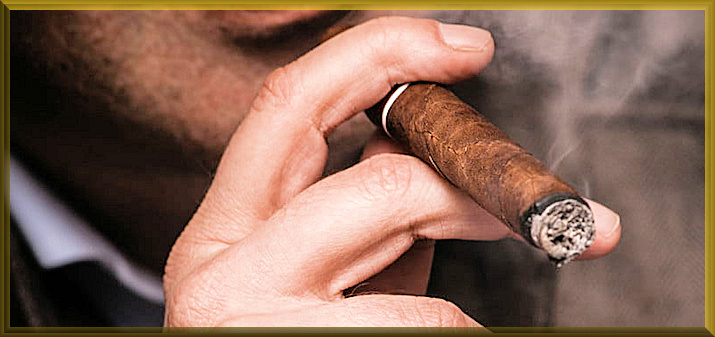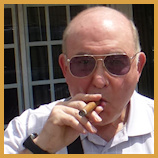|
HOW TO SMOKE A
CIGAR - BETTER
TABLE OF CONTENTS
INTRO
You already know that the best way to smoke a cigar is the way you are doing it now -- otherwise, you wouldn't
be smoking your cigar that way.

Or would you?
But, are there some other little techniques that you could employ at would make your enjoyment of a cigar even
better?
For the newbie, there are excellent guides and suggestions on cigar selection, maintenance, and smoking at a variety
of websites. I will furnish some helpful links at the bottom of this discussion. You are encouraged to go to them
for other high-quality guidance.
What I am presenting below are some of my small suggestions (with REASONS & HINTS)
that may or may not be included in many cigar smoking tutorials.
Experiment with them to see if any make a difference and enhance your cigar smoking experience. Only adopt what
makes sense and pleases you.
EVEN
BEFORE SMOKING
TAMP TAMP TAMP
| I probably don't even have to mention this, as you have undoubtedly,
by this time, have |
|

|
discovered -- the hard way -- that it is best to tamp the to
be lit end (also known as the "foot" of the cigar) a few times on a surface before lighting up. |
| |
REASON: There may be small bits of loose
tobacco leaf that when initially ignited will fall on your clothing, furniture, rugs or skin (ouch) causing damage
or burns. The tamping will reduce this possibility. A word to the wise. |
YOUR CIGAR BAND(S) Some have two
Here is something to think about - the removal of your cigar band(s). Some smokers like to remove the bands before
lighting up [Not necessaraly recommended.
See comments below] while others wait until their
cigars are partially smoked. Sometimes at the last second before they either burst into flame or smother the  cigars. cigars.
If you are the former, then you know that MOST
ALL cigars have their bands wound counterclockwise
as you would look at the mouth end of a cigar. By using your nail under the top edge of the band you can lift and
unwind the band in a clockwise direction. [I have found a couple varieties of cigars have their bands wound opposite
of what I have just described [Example: 5 Vegas.] But there is the probability that there are more. So look
first.]
REASON: If you wait too long you may find yourself struggling with the
removal of the band, burning your fingers and/or dropping lit ashes all over the place
.
HINT: If you like to smoke your cigar with the band on (I do), before lighting up, just use your nail
to bend over a little corner of the band's end which will become a 'pull or starting point' and will greatly facilitate
the band's removal at a later time of your choosing without your struggling and possibly disturbing
the wrapper or ash. Also as the foot of the cigar is approaching the band it's heat may soften the band's glue
facilitating the removal.
ADDITION 180318 - You may find that some cigar bands just happen to be loose 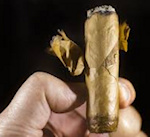 around the cigar. In that
case, the band can easily be slipped off the head end of the cigar when desired. Hopefully, this occurrence is
not due to an improperly humidified cigar which has shrunk in width which might provide you with a less than desirable
smoke. Sometimes the heat from the being smoked cigar will cause the band to loosen so that it may be easily slid
off. But here is a warning - be very careful that during the "slip-off" maneuver,
that you, at the same time, don't catch and tear the wrapper with the band as you might be quite sorry if you do
as your smoking enjoyment will be most certainly lessened due to the damaged wrapper -- that you inadvertently
caused. You do run the risk of damaging the wrapper or facilitating the wrapping releasing from the binder if you
remove it too early. A word to the wise. around the cigar. In that
case, the band can easily be slipped off the head end of the cigar when desired. Hopefully, this occurrence is
not due to an improperly humidified cigar which has shrunk in width which might provide you with a less than desirable
smoke. Sometimes the heat from the being smoked cigar will cause the band to loosen so that it may be easily slid
off. But here is a warning - be very careful that during the "slip-off" maneuver,
that you, at the same time, don't catch and tear the wrapper with the band as you might be quite sorry if you do
as your smoking enjoyment will be most certainly lessened due to the damaged wrapper -- that you inadvertently
caused. You do run the risk of damaging the wrapper or facilitating the wrapping releasing from the binder if you
remove it too early. A word to the wise.

ADDITION 180814; SLIGHT
REVISION 210526 - If you remove the band before you smoke your cigar you run the risk
of tearing the wrapper, especially if some object or even some excess glue is bonding the band to the wrapper.
If the wrapper gets torn it more than likely than not will open up an air passageway and may keep you from being
able to draw properly, thus ruining your anticipated smoking experience. Even worse, it might cause the entire
wrapper to begin to become unraveled destining the cigar for the trash bin. Now if a slight tear occurs you can
fix it using cigar repair glue and crack sealer [I will discuss this in a later section]
but I have never seen anyone use this product in public except myself and a couple of other smoking buddies whom
I have instructed in this technique. But who knows how many cigar smokers are doing this at home with great success.
There apparently is a lot of glue and crack sealer sold on the internet and in the cigar shops.
MOISTEN THE END
Before you cut the mouth end (also known as the "head") of the cigar you are about to light, moisten
it with your tongue and lips. A good way is to place the cigar in your mouth and rotate it clockwise while wetting
it with your tongue.
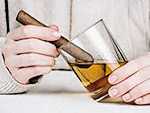 |
|
REASONS: Most outer leaf cigar wrappers will be affixed in a counterclockwise direction (but check your
particular cigar) and there will be less chance of you disturbing the wrapper if you follow the above.
By doing this you will help prevent the wrapper from splitting and flaking during the end cutting or punching and
will create a cleaner cut or punch. |
Of course you may develop alternate methods of moistening
the end of a cigar. I am also assuming here that you have treated your cigars well and that they a properly humidified
in the process.
CUTTING THE END
ADDITION 190514 - There are several ways of cutting the mouth end of a cigar before
smoking. Some may be more s uitable for a larger or smaller ring size and the firmness of the cigar. uitable for a larger or smaller ring size and the firmness of the cigar.
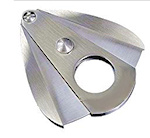
Some popular cigar end cutters include the guillotine, V-cutter, scissors, punch, Shuriken 6-slit cigar cutter,
and a rusty nail. Some people just bite the end off -- at least in the movies. Remember Edward G. Robinson?
You will soon know, by experimentation, which is best for each type of cutter for each of the varieties of cigars
you smoke.
REASONS: You may find that cutting a very firmly hard draw cigar with a
punch is not the best choice and in that case, a guillotine or V-cutter would be a better selection. If you are
smoking a small ring cigar, perhaps only the guillotine cutter would be your proper choice. And please forget about
using a rusty nail.
HINT: I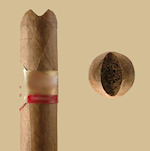 t
is important that you not cut too much from the head end of the cigar if you are using a guillotine or scissors
style of cutter. Only cut between the mouth end and the shoulder of the cigar. Some readers report that their number
one choice, especially for cigars that have an ample ring size, is the V-cutter. They like the way the cut is easily
made and does leave part of the cap untouched from its original position allowing it to hold the filler leaves
in place. This is especially important if your cigar happens to be constructed with shorter filler leaf pieces.
I personally keep a heavy duty guillotine cutter, a V-cutter, and several sizes of good quality punchs available
and use them selectively, according the shape, ring size, and cap of my intended smoke. t
is important that you not cut too much from the head end of the cigar if you are using a guillotine or scissors
style of cutter. Only cut between the mouth end and the shoulder of the cigar. Some readers report that their number
one choice, especially for cigars that have an ample ring size, is the V-cutter. They like the way the cut is easily
made and does leave part of the cap untouched from its original position allowing it to hold the filler leaves
in place. This is especially important if your cigar happens to be constructed with shorter filler leaf pieces.
I personally keep a heavy duty guillotine cutter, a V-cutter, and several sizes of good quality punchs available
and use them selectively, according the shape, ring size, and cap of my intended smoke.
ADDITIONS 191222 - Punch cutters come in a variety of dimension sizes. You probably
wouldn't want to use a large diameter hole punch on a small ring sized cigar. Good luck with that. Besides the
variation of the punch diameter, they are made with different lengths. Just because you own a punch with a long
neck doesn't mean that you need to jam it into your cigar up to the hilt. Your purpose should be to break through
the wrapper at the cap - a little way, not to dig out the biggest well possible.
Have a couple of various size punches available to meet
your current cigar needs or switch to using a V-cutter or guillotine cutter.
Also, when smoking cigars containing small pieces of cut-leaf fillers that are cut with a guillotine cutter, you
might encounter, while smoking, an abundance of tobacco pieces in your mouth from time to time. That may or may
not be a problem for you. Punches may alleviate some of that problem.
BLOW, BLOW, BLOW
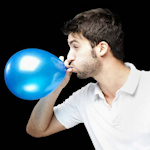
This is often overlooked. Before even attempting to light your cigar, blow into it a couple of times at the cut
end.
REASON: By blowing into your cigar you will be adding a little moisture
to its innards, helping it to create a more even burn while smoking. Also, in some over-aged cigars the tobacco
can begin to break down and produce dust. When blowing (or purging) into your cigar and you see dust coming out
the foot end you are being warned that this has happened. You will most probably find that smoking this particular
cigar will not be as good as you had hoped or expected.
HINT: Pretend you are blowing up a balloon. If you find that blowing thru the cigar is difficult and
drawing through it is also difficult, the cigar may have been rolled too tight during its construction. Your only
salvations, short of selecting another cigar, are making the cut in the mouth end a little bigger, giving the cigar
a nice massage (be careful not to damage the wrapper), and/or using a cigar draw poker which pokes from the cigar's
head to foot creating a controlled tunneled air passage.
THE PICKS (LONG & SHORT)
LONG PICK

ADDITION/REVISION 190928 - No, it's not the type of pick that you would use to mine gold,
nor is it
- a lottery pick for multi riches, nor is it
- a basketball pick to score the winning point, nor is it
- that elusive search for that nasty annoying booger.
I'm talking about the long cigar pick, sometimes known as the "draw poker", cigar tool, draw tool, draw
enhancer, cigar spike, cigar rod, etc. To be honest, you rarely see someone using one in public for draw enhancement,
so smokers must be using them at home. There is another use for some shorter versions of this tool, which I will
discuss later.
From time to time you might find a cigar that is so firmly packed that after cutting the mouth end that it is difficult
to draw through the cigar. This may happen to lesser quality cigars but it is certainly not unknown to even a premium
cigar from time to time. There are a number of reasons that this could happen. The occasional poor craftsmanship
of a single (or more) unit of a hand-rolled cigar, a faulty adjustment of equipment for machine-made cigars, an
excessive shrinking of a cigar while "resting" before being sold, an inappropriate humidor humidity level,
etc. In situations like this, the pick can probably salvage your cigar, be it in any price range.
Before lighting your cigar and as part of your preparation ritual you should gently squeeze your cigar down most
of its length. You are testing for firmness - which is desirable - but not for a brick hard feel which may indicate
that you might have draw problems as you begin to smoke.
HINT - you want to test the entire length, except the cap, as some cigars
are too dense in one area and not another which would give you a clue as to what type of pick to use. Pressing
on the cap might pop it or crack it in a way that is undesirable. So be careful with that end.
HINT - you may want to return the cigar to the humidor for a period of
time if you feel that dryness might be your problem, and choose another stogie. Sometimes aging in a humidor may
help. Especially for newly constructed cigars.
If a pick is indicated for rescue you might use a long one or a shorter one depending if the firmness is throughout
the entire length or at just a small portion of either end.
The long cigar pick (or poker) - this is a long sturdy bend resistant small diameter pointed round
rod that will traverse, end to end, down the MIDDLE of your cigar creating a tiny controlled tunnel permitting
an easier draw. Some may look like an ice pick, a kabob skewer, a pointed knitting needle or a piece from a "Pickup-Sticks"
game (you younger people won't remember this.)
HINT - rather than inserting, then immediately withdrawing the rod, it
is best to leave it in the cigar, a least for a while letting it establish itself, due to the pressure on the tobacco,
creating less chance of the formed tunnel from collapsing upon withdrawal.
WARNING - please do not attempt to insert any type of LONG pointed rod all
the way through the cigar barehanded. First, it is doubtful that you will be able to keep it exactly
centered during its traverse. I predict that it will skew through the tobacco piercing the binder and wrapper and
possibly even injuring your hand. Not to mention ruining your cigar. But not to worry. There are devices that support
your cigar guiding the rod through the exact center of your hard cigar. One such device that I use at home (but
that is rarely needed) is the Drawpoker, but there are others. [Check Google and Google Images for ideas (re: "drawpoker cigar", "cigar pick".)]

SHORT PICK
This is a shorter, sturdy, and bend resistant pointed device
available in a multitude of styles ranging from just a toothpick, nail, or hat pin, to an ornate bejeweled expensive
pointed device. Some even have drill or awl bit designs to really unplug the tight mouth-end of an unevenly rolled
cigar. [Check Google and Google Images for "short
cigar pick tool".]


CONFESSION - I have used the longer draw poker device to improve the flow of
air through a very firmly rolled cigar, which also provides a pathway through the mouth-end of a cigar in one
operation.
NOTE -I won't go into cigar brands but there are many brands that I have
purchased that are extremely well made and very, very, firm to the touch but, with which, I have never had the
need to use any poker device as they draw perfectly well, as is.
I don't often run across a cigar that seems to be overly tight at the mouth-end only. [Some
torpedo style, as well as others, may suffer from this problem.] In those few instances, I found that a simple
wooden toothpick was of sufficient length and sturdiness to be used as a short draw tool. El Cheapo.
WARNING - It is recommended that you be quite deliberate and careful when
using a short pick, especially one made in the sharp fancy hatpin style. If you are not paying attention to the
insertion direction and pressure you are using on both the pick and holding the mouth of the cigar in support,
you might damage the wrapper. Or worse, poke a hole in the side of your cigar and into your finger. Ouch!
GLUE-TA-CUS - SAVE-A-CUS
ADDITION 190928 Eventually,
you will get ready to smoke one of your cigars and find that the wrapper is cracked, or the wrapper is becoming
unraveled, or the wrapper has a hole or some other imperfection that would interfere with a proper draw and your
enjoyment. You might just throw your cigar away in your exasperation (which may be expensive) or you might easily
fix it yourself.

SLIGHT REVISION 190928 Some people may just lick the loose wrapper with their wet tongue
hoping that the wrapper would stick back long enough for them to enjoy their cigar without interruption or try
to tear off an offending piece of the raised wrapper. [How are those tricks coming along?]
Others might quickly repair their cigar using cigar repair
glue & crack sealer. Ta Da!
 SLIGHT REVISION 210912 First, let me encourage you to properly store your cigars in a correctly humidified environment
such as a humidore. If your cigar has dried out, somewhere along the path from the manufacturer to where you decide
to smoke it, it may have developed dry wrapper problems. Being wrapped in cellophane may have prevented some drying,
but don't depend on it. I currently choose, for humidore storage of my cigars, somewhere in the range of between
65% (summer) to 70% (winter) relative humidity but you might choose another number in that area (or near it) dictated
by your environment, location, season, cigars, and your needs. SLIGHT REVISION 210912 First, let me encourage you to properly store your cigars in a correctly humidified environment
such as a humidore. If your cigar has dried out, somewhere along the path from the manufacturer to where you decide
to smoke it, it may have developed dry wrapper problems. Being wrapped in cellophane may have prevented some drying,
but don't depend on it. I currently choose, for humidore storage of my cigars, somewhere in the range of between
65% (summer) to 70% (winter) relative humidity but you might choose another number in that area (or near it) dictated
by your environment, location, season, cigars, and your needs.
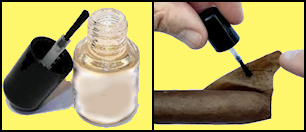
Cigar glues (plant-based) can assist in re-gluing sections of loose wrapper pieces and cigar caps plus blocking
holes, wrapper cuts, and tears. They are quite inexpensive and easy to use. Most are quick drying allowing you
to smoke your repaired cigar almost immediately. If you can save even one of your expensive cigars the glue will
have paid for itself. Please don't experiment with Elmers' Glue, Krazy Glue, Epoxy, Bondix, Loctite Silicon, and
Flex Glue. Get the real stuff.
A little dab will do ya - and I don't mean Brylcreem.
There are several (plant-based) available types including:
- Cigar Glue - used during making cigars holding the leaf
wrapper and cap together
- Cigar Repair Glue with cellulose - containing tiny fibers that instantly form a net over
the damaged hole, crack, or loose wrapper [Recommended by me]
- Cigar Gum Powder [Cigar Roller Glue] - a powder which you dissolve in water (sometimes
heated) [a popular brand: Bermocoll 320]
- Other professional rolling adhesives [I have not had experience with these]
On my recent tropical cruise where serious cigar smokers joined together after lunch and also nightly for smoking
and interesting conversations, several cruisers found that a few of their great cigars had suffered damage during
luggage transfers from home, car, aircraft, and ship loading. I was carrying my cigar repair glue in my kit and
was able to, in seconds, repair some nice stogies for members of the group.
You can do double duty. "Save the Whales" as well as "Save the Cigar" (with Cigar Repair Glue.)
LIGHTING YOUR CIGAR
TECHNIQUES
 |
At this point, many just place a cigar in their mouth, take
some sort of lighter, and burn the hell out of the end and a bunch of the wrapper, drawing deeply (usually creating
an unwanted internal cone (or funnel) of burning tobacco.) Try to resist this. And at all times be gentle with
your drawing intakes. |
HINT: As an experiment, try the following technique and see if it doesn't create a better smoking and
better tasting technique. I learned this in Paris France in the early 1960s when I was living and working there
and have practiced it ever since as it creates a better smoking experience, at least for me. See icons 
Also, don't be reluctant in trying OTHER techniques that you may see or read about as they may be even better
for you.
 TOASTING THE END TOASTING THE END  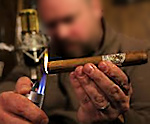
The initial objective is NOT to light the cigar, but to only gently toast its end - not the wrapper,
keeping the direct flame (the colored part) at a slight distance. Using your torch (butane) lighter, WOODEN
match, lit cedar spill (stick), or whatever (but no gas lighters similar to Bics), just toast the end evenly while
holding the cigar and rotating it in a full circle. Again, do not let the flame touch the cigar.
The cigar is NOT in your mouth at the moment. Try and concentrate the heat towards the foot of
the cigar without letting the flame touch.
REASON: This will help toast and set up the foot end for a second, more
even lighting. It will also facilitate the bonding of the wrapper and the binder further inhibiting the possibility
of a wrapper unwinding during your enjoyment of your cigar.
 WIND YOUR WATCH WIND YOUR WATCH 
Holding your cigar between your first and index finger, vigorously shake it as if you were winding a self-winding
watch for about 20-30 shakes.
REASON: This will fan the cigar's end causing and more even burn without
really advancing the smoldering area into the interior the cigar, helping to even the burn. It will also bring
attention to you from all the other cigar smokers in the room who will be wondering what the hell you are doing.
Your explanation to them will make you sound like an expert. Tell them that it is a French technique or a technique
taught to you by the Dutch Masters or even Fidel. It's OK to tell a little white lie at this point.
NOTE: Some smokers, instead of shaking their cigars, blow on the end that they just toasted. This is
certainly acceptable, but be careful as you may blow a lit ash on your, pants, shirt, sofa, or rug while doing
this, causing unwanted damage and embarrassment.
 THE SECOND LIGHTING THE SECOND LIGHTING  
Now continuing, relight the END again, with
the cigar out of your mouth in the same manner
as above. Be sure to rotate it as you are relighting.
REASON: This time you will notice that the desired red glow will be spread
evenly over the end of the cigar, facilitated by the previous toasting and shaking (or blowing) and will assist
in a slow-burning even disk of embers advancing down your cigar as you enjoy it.
ADDITION 190818 - Now, at this point, your cigar is lit by this thin slow-burning disk.
There is no need to place it in your mouth
and relight it again running the almost predictable
chance that you could cause tunneling or canoeing of the cigar. I do know that others will suggest lighting your
cigar while in your mouth, so, try both ways and determine which way suits you best.
ALMOST THERE
One last thing before you begin smoking your cigar. RESIST the temptation of drawing in, but first GENTLY BLOW OUT (or purge)
through the cigar for one breath.
REASON: It is said by some writers, that this will help to expel (purge)
any residue of gases, sulfur, or lighter fluid that may have been trapped during the lighting process. I also note
that it facilitates the even and complete burning of the aforementioned disk which will aid an improved burn of
your cigar.
SMOKING
AND ENJOYING YOUR CIGAR
OK. now we are getting down to the brass tacks of enjoying your cigar. From all this preparation your cigar is
now lit and has produced a small even ring of ashes.
THE SLOW DRAG
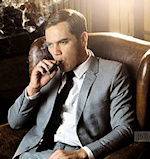 |
Nothing too forceful or too often. Overheating your cigar will produce negative smoking results. You will develop
a timing that will allow you to keep your cigar lit and not extinguished by too infrequent a drag. Experience here
is your best teacher.
REASON: You are endeavoring to keep your cigar burning at a slow rate without
causing it to burn hotter than it should. The stronger your draw, the hotter it will burn, causing more tar build-up
and promoting an increased bitter unpleasant taste.
|
TURN, TURN, TURN
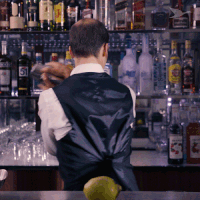
After each drag, it might behoove you to turn your cigar
while in your mouth about a quarter of a turn.
REASON: Your objective is to keep the ash burning regularly as you smoke
your cigar preventing just one section burning down.
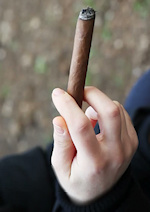
VERTICAL IS UP
Holding the cigar in a vertical position when out of your mouth is strongly suggested.
REASON: Again this will greatly assist you in creating an even burn down
the cigar and help to prevent one side burning way down too quickly. I realize that this may be difficult to accomplish at times, so try and do it as much as possible
to promote the even burn.
OILS IN MOUTH
When you smoke to enjoy a cigar, don't be too quick to expel the smoke.
 |
REASON: The smoke contains an essence of oils and flavors that will begin
to coat the inside of your mouth, tongue, and even lips, so that you can BETTER appreciate the taste
when you give yourself the time.
HINT: With the smoke in your closed mouth, take a breath of air THROUGH YOUR NOSE while not
disturbing the trapped smoke in your mouth which is doing its 'flavorful job' of bringing you pleasure and taste.
After your breath (some do two or more), slowly and gently blow the smoke from your mouth and pay attention to
the taste that you are experiencing. Even your lips will have a pleasant taste - at least to you.
|
ASHES OFF
 |
As your cigar burns while being smoked, an ash forms at the
lit end (as if you didn't know.) Don't be too quick to knock or flick it off. At the same time don't be too slow
only to have it fall in your lap. Ouch! |
| You will find that it is a sort of balancing act depending
upon your method of smoking and the construction of the cigar. Some cigars, usually of higher quality, can support
a longer ash, while others can't. This is where your experience with the particular cigar comes into play. Many
cigar aficionados report that a cigar burning with a longer ash is better. Your personal trial and errors are important
here. Take your time. Don't approach this in a 'half-ashed' manner. |
 |
HINT: Speaking of knocking off the ash, be gentle here too. Just roll the ash lightly on the inside
of the ashtray. It will then take care of ash removal in the appropriate amount. Then take a gentle puff right
after you knock off the ash.
REASON: Some of the residual heat will also be removed when the ash leaves the cigar and you will want
to take that gentle puff to rekindle the even burning glowing tobbaco [the "cherry" or ember] that existed
before you removed the ash. If you wait too long you might find that your cigar goes out. Bummer.
ADDITION 191223 - REASON: Let us examine the residual heat for a moment. While smoking your cigar let an inch or more of
ash develop. Now turn off the lights in the room and inspect that ash. You will notice a cone of reddish-orange
smoldering area inside the ash. Some call this the "cherry." This is a source of contained heat tha t helps to keep
your cigar lit. This cherry [ember] of heat allows you to take softer puffs providing you with a cooler smoke. t helps to keep
your cigar lit. This cherry [ember] of heat allows you to take softer puffs providing you with a cooler smoke.
When you knock off all of the ash, that extra heat source
is gone, although a thin disk or "cherry" of smoldering ash should remain (hopefully). This disk is considerably
cooler (less available heat) than the former heat cone and may soon extinguish unless tended to carefully, requiring
you to re-light your cigar. This is why I mentioned earlier, when you remove your ash, or when it falls off by
itself, you should immediately take a gentle puff, or puffs, to reenergize the internal smoldering.
Also, you, when removing smoldering ash, should not be haphazard
nor energetic trying to remove all ash at once, but gently roll the side of the ash against the ashtray's inner
surface so that all of the smoldering cone (that heat source that I was addressing) is not altogether removed in
one fell swoop and can aid you in keeping your cigar lit.
RE-LIGHTING
This is where a torch lighter comes in handy. You can take a cigar that needs re-lighting in one  hand and the torch in the other and direct
the flame(s) towards the end of the cigar while holding it over an ashtray or some other receptacle to catch any
errant droppings -- especially anything that may be hot or lit. In this case, do not use the 'wind your watch'
action mentioned in the paragraph concerning initially lighting your cigar unless you want to turn your cigar into
a 4th of July sparkler. If you would rather re-light the cigar while in your mouth, please make sure your name
is not Pinocchio or you'll suffer dire consequences. Remember the preferred method of lighting a cigar, whether
initially or during a re-light is when the cigar is NOT in your mouth. hand and the torch in the other and direct
the flame(s) towards the end of the cigar while holding it over an ashtray or some other receptacle to catch any
errant droppings -- especially anything that may be hot or lit. In this case, do not use the 'wind your watch'
action mentioned in the paragraph concerning initially lighting your cigar unless you want to turn your cigar into
a 4th of July sparkler. If you would rather re-light the cigar while in your mouth, please make sure your name
is not Pinocchio or you'll suffer dire consequences. Remember the preferred method of lighting a cigar, whether
initially or during a re-light is when the cigar is NOT in your mouth.
HINTS: First, before re-lighting, dislodge the ash, if necessary, and blow gently into the mouth of the
cigar purging any old smoke and residual gases that may be lingering. Then remove it from your mouth for the actual
lighting.
When you place the cigar back in your mouth, after being lit, again, another purge, then take gentle puffs to get your cigar going again.
LIGHTER IN FREEZER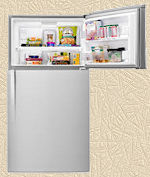
If you use a butane refillable torch lighter you might like this following hint.
HINT: Place your torch lighter in the freezer of your refrigerator for an half-hour before you intend
to fill it. The difference in temperature between the gas in the butane container and your cold lighter will allow
more gas to enter the chamber of your lighter.
THE NEW CIGAR ACQUISITION
ADDITION/190928 Normally,
when you purchase your cigar from a brick and mortar cigar store, especially one that has a walk-in humidor (or
the entire store is properly humidified), you can light up and enjoy your acquisition as soon as you reach an area
where smoking is not banned.
This MAY NOT be true if you obtained your stick(s) via mail-order. Who knows to what environment they may have
suffered during storage, transportation, and delivery via truck, airplane, car, boat (? - maybe) and foot. Were the
conditions to hot, cold, dry, moist, or under/over pressurized? Were they resting in a box on your porch in the
sun, cold, or dampness of the environment until you returned home?
It would b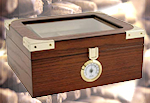 e best, once they arrived, to place them in your humidity controlled
at-home humidor for them to return (if they have suffered) to their most ideal state. I know you are anxious to
get started with them, but you also want 'the best' out of your first smoke especially if they are of a new brand
for you. e best, once they arrived, to place them in your humidity controlled
at-home humidor for them to return (if they have suffered) to their most ideal state. I know you are anxious to
get started with them, but you also want 'the best' out of your first smoke especially if they are of a new brand
for you.
Once, in Barcelona, I purchased an excellent local country
cigar (I'm always experimenting) in a downtown smoking shop. I liked it. So the next day I went back and purchased
two bundles to take home to the United States . Each cigar was cellophane wrapped and each bundle was also cellophane wrapped. My new
cigars were subjected to the inside of my luggage which traveled by taxi, boat (crossing the Atlantic), van, airplane,
US Customs, and car during its voyage. . Each cigar was cellophane wrapped and each bundle was also cellophane wrapped. My new
cigars were subjected to the inside of my luggage which traveled by taxi, boat (crossing the Atlantic), van, airplane,
US Customs, and car during its voyage.
My first cigar, from the bundle, was not the best and didn't
present itself as the taste of the cigar that I enjoyed in the Spanish shop on Las Ramblas in Barcelona. However,
after I unwrapped the bundles and the cigars and placed them in my humidor to 'home cure' for a week or two, they
bounced back to the smoking condition that I experienced in Spain.
So, for a better smoke, consider giving those mail-order cigars, a little home humidor rest, first.

I most probably will be adding more hints and tips to this web page blog in the future so check back every once
in a while to see what's new. I will place additions and contrbutions at the bottom of each section so that you
can easily identify them. Plus I always do a lot of tweeking to my writings.
YOUR SUGGESTIONS

Perhaps you have some suggestions, hints or techniques that you would like to contribute to this web page. Please
feel free to email me at ghayman3@comcast.net. I will
be glad to include your worthy contributions on this page giving you full credit.
This web page is for the benefit for all cigar smokers who are interested. It contains some suggestions, ideas,
and hints that may be of value to some. It is not meant to be, nor is it, the final word. If there is something
posted here that is of value to you, then you are a winner for finding it.
Happy Smoke Rings.
Gary Hayman

|
